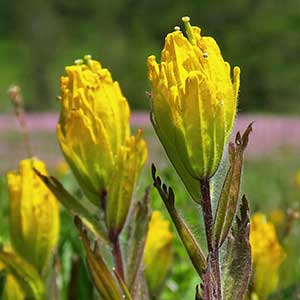Castilleja levisecta
Castilleja raupii
golden Indian paintbrush, golden paintbrush
Raup's Indian paintbrush, Raup's paintbrush
few to many, erect, ± decumbent or creeping at base, unbranched, sometimes branched, hairs spreading, medium length and long, soft, mixed with short stipitate-glandular ones.
few to many, erect to ascending, unbranched or often branched distally, glabrous proximally or hairy, hairs sparse, retrorse, short, ± stiff proximally, distally ± dense, spreading, longer, soft, eglandular throughout.
green to purple or brown-tinged, linear-lanceolate proximally, oblong-ovate or -obovate distally, 0.8–5.2 cm, not fleshy, margins plane, distalmost sometimes ± wavy, involute, 3–7(–11)-lobed, apex obtuse;
lobes erect to ascending, linear to linear-spatulate, very short, toothlike, usually arising from distal 1/3 of blade, apex rounded.
purple to green, linear to lanceolate-linear, 2–8(–13) cm, not fleshy, margins plane to slightly wavy, flat or slightly involute, 0-lobed, sometimes 3-lobed distally, immediately below inflorescence, apex narrowly acuminate to acute;
lobes ascending, linear, apex acute.
2.5–25 × 1–4 cm;
bracts bright yellow throughout, or proximally greenish, distally bright yellow, sometimes deep yellow-orange, especially with age, oblong, elliptic, or obtuse to ovate, (0–)5–9(–13)-lobed, sometimes wavy-margined;
lobes erect to ascending, oblong, short to medium length, arising above mid length, central lobe apex rounded, lateral ones rounded to acute.
2.5–12 × 1.5–3.5 cm;
bracts lavender, pink-purple, or reddish purple throughout, sometimes distally white, cream, or pale pink, lanceolate, oblong, broadly elliptic, or ovate, 0–5(–7)-lobed;
lobes spreading to ascending, linear to narrowly lanceolate, short, arising above mid length, central lobe apex acute to obtuse, lateral ones acute.
straight or slightly curved, 17–28 mm;
tube 12–15 mm;
beak exserted, adaxially green or greenish yellow, 6–8 mm;
abaxial lip yellow or greenish, reduced, not inflated, 2–3 mm, 25–33(–50)% as long as beak;
teeth ascending to erect, yellow, 0.5–1.5 mm.
straight or slightly curved, 15–20(–26) mm;
tube 10–13 mm;
beak and abaxial lip ± exserted;
beak adaxially green, 4–6.5 mm;
abaxial lip purple, magenta, or red, slightly inflated, pouches 3, 2–5 mm, 75–80% as long as beak;
teeth erect, magenta, pink, or red, 1–1.5 mm.
distally yellow, 13–22 mm;
abaxial and adaxial clefts 4–9.5 mm, 30–40% of calyx length, deeper than laterals, lateral 2.5–4.5 mm, ca. 25% of calyx length;
lobes linear to narrowly oblong or narrowly lanceolate, apex obtuse, sometimes rounded to acute.
colored as bracts, 13–20(–25) mm;
abaxial and adaxial clefts 6–11 mm, 50–60% of calyx length, deeper than laterals, lateral 0.5–3.5(–7) mm, ca. 25–30% of calyx length;
lobes lanceolate-linear, apex narrowly acute or acuminate.
= 24.
= 72.
Castilleja levisecta
Castilleja raupii
Castilleja levisecta is listed as threatened in the United States and endangered in Canada, where it is extremely rare. Most of its grassland habitat has been altered by development in the Puget Trough, and there are historical stations in the metro areas of what are now Victoria, Portland, and Seattle. For several decades, C. levisecta was considered extirpated from Oregon. However, recent reintroduction programs in Oregon and Washington have been very successful at reestablishing this species at several sites in the Willamette Valley. The bright yellow inflorescences often gradually age to a golden yellow color, unique in the genus.
Castilleja levisecta is in the Center for Plant Conservation’s National Collection of Endangered Plants.
(Discussion copyrighted by Flora of North America; reprinted with permission.)
Castilleja raupii is a member of the difficult C. pallida species complex. Castilleja raupii is widespread from southern Alaska to northern Alberta, northwards to the shore of the Arctic Sea, and east to the eastern shore of Hudson Bay. Reports from northeastern Russia are mostly referable to the similar Asian species, C. rubra (Drobow) Rebristaya. Castilleja raupii is sometimes confused with the partially sympatric C. elegans, but C. raupii is a taller plant with often somewhat branched, ascending-erect stems and is often found on more mesic substrates than C. elegans. The inflorescences of C. raupii are usually pink to pink-purple, but more variably colored populations are reported from the delta region of the Mackenzie River in the Northwest Territories of Canada.
(Discussion copyrighted by Flora of North America; reprinted with permission.)


